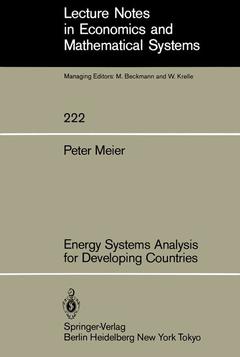Energy Systems Analysis for Developing Countries, Softcover reprint of the original 1st ed. 1984 Lecture Notes in Economics and Mathematical Systems Series, Vol. 222
Langue : Anglais
Auteur : Meier P.

The lecture notes presented in these pages were originally developed for use in the Energy Management Training Program (EMTP), sponsored by the Office of Energy, U. S. Agency for International Development. This program, held at Brookhaven National Laboratory (BNL) and the Institute for Energy Research, State University of New York at Stony Brook, is designed to train mid-career and senior government officials in developing countries in the techniques of energy policy analysis and planning, and covers, in addition to the material presented here, more detailed case studies in resource evaluation, pricing, conservation, financial analysis, and investment planning. Since its incep tion in 1978, some 220 individuals from 57 countries have attended the course. These notes have also been used in executive level seminars and in country training programs in the Sudan, the Dominican Republic, and the People's Republic of China. Attendance at the course is diverse, and typically includes planners, managers, engineers, and economists from energy planning agencies, ministries of finance and economic development, electric utilities, refineries and State Oil Companies, and specialized energy planning units for energy conservation and for regional cooperation. The monograph is designed not just as reading material to support lectures, but also as a general self-contained reference text for a very diverse audience: we have therefore included much introduc tory material. The presentation is focused on a discussion of the basic principles of systems analysis: and the case material has been specially designed to illustrate these principles.
1 Introduction.- 1.1 What is Energy Systems Analysis.- 1.2 Applicability of Energy Systems Analysis to Developing Countries.- 1.3 A Framework for National Energy Planning.- 1.4 Scope of This Book.- 2 Mathematical Fundamentals.- 2.1 Matrix Algebra.- 2.2 Econometrics.- 2.3 Linear Programming.- 2.4 Classical Optimization Techniques.- 2.5 Statistical Analysis of Energy Data: Oil Consumption in Tunisia.- 3 Network Models.- 3.1 Reference Energy Systems.- 3.2 Energy Demand and Fuel Mix Analysis.- 3.3 Matrix Algebraic Formulation: Application to the Dominican Republic.- 3.4 Matrix Notation for Fuel Mix Tables; Residential Demand in the Dominican Republic.- 4 Econometric Models.- 4.1 Estimating Elasticities.- 4.2 Estimation Problems.- 4.3 Application: Income and Price Elasticity of Energy Demand in Tunisia.- 5 Petroleum Sector Models.- 5.1 Technical Background.- 5.2 A Simple Refinery LP.- 5.3 Application to a West African Refinery.- 5.4 Application: Refinery Rehabilitation in Bangladesh.- 6 Input-Output Models.- 6.1 Fundamentals of Input-Output Analysis.- 6.2 Energy Denominated I/O Tables.- 6.3 RES-Transaction Table Relationships.- 6.4 Interfuel Substitutions in the I/O Framework.- 6.5 An Energy Input-Output Model for Portugal.- 7 Industrial Process Models.- 7.1 Introduction.- 7.2 A Process Model of the Egyptian Iron and Steel Industry.- 7.2.1 Introduction.- 7.2.2 Options for the Egyptian Iron & Steel Industry.- 7.2.3 Formulation as a Linear Program.- 8 Electric Sector Models.- 8.1 Introduction.- 8.2 The Capacity Expansion Problem.- 8.3 Adding a Spatial Dimension: The Siting Problem.- 8.4 The Treatment of Electric Transmission in Spatial Programming Models.- 8.5 Incorporating Water Resource Planning Considerations.- 8.6 Environmental Considerations.- 8.7 An LP of the Jordanian Electric System.- 9 Energy System Optimization Models.- 9.1 The Basic Linear Programming Model.- 9.2 Capacity Variables.- 9.3 Interpretation of the Shadow Prices.- 10 Simulation Models.- 10.1 Introduction.- 10.2 An Energy Cash Flow Simulation Model.- 11 Energy Economic Linkages.- 11.1 Linking the I/O and LP.- 11.2 Process Model Linkages.- 11.3 Macroeconomic Linkages.
Date de parution : 01-1984
Ouvrage de 348 p.
17x24.4 cm
Thèmes d’Energy Systems Analysis for Developing Countries :
© 2024 LAVOISIER S.A.S.
